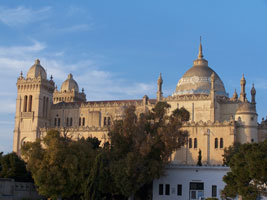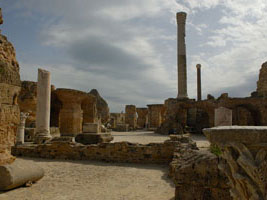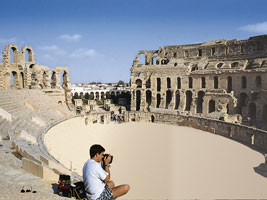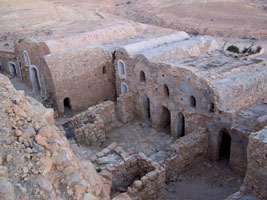

Artours & Events deals with worldwide MICE & Business Travel Agencies. Our customers are treated as PARTNERS and We appreciate and respect the trust in our Team work. Our Partners are from: Automobile Industry, Pharmacy & Cosmetic, Bank, Corporate and others, and we always do our best to make any stay or Event just successful and ensure warm memories.
We offer the following:
Monastir: old Punic city then Roman of Ruspina. You will visit the '' Mausoleum '' of Bourguiba and Ribat where the access to the tower is allowed to the visitors from where they can enjoy a beautiful sight on the unit of the monument and bay of Monastir.
Ancient Phoenician city, it receives, undoubtedly as of the time Caesarean, the statute of Roman colony then is integrated into the province of Byzacène. At the periphery of the city, the archaeological museum presents many mosaics resulting from the excavations in the Roman villas of Thysdrus. The amphitheatre of El Jem, also called Colisée de Thysdrus, is probably built in 238 a. J. - C. under the proconsul Gordien (who becomes Roman emperor in the middle of the year) and probably shelters combat of gladiators as well as races of tanks and other circus games. Its radiant structures have a surface of 147,90 meters out of 122 meters and its arena measures 64,50 meters out of 38,80 meters
Visit of Guellala an its pottery shops, Continuation to Hara Sghira, visit of the synagogue La Ghriba, Visit of Houmt Souk, capital of the Island, the museum of carpets’ manufacture and the port.
Shopping
On the roads of the Great South you will meet several mysterious sometimes strange constructions. There are Ksars which can be classified according to their situation in Ksar of plain or mountain. Their architecture mentions if there are Berber or Arab Ksar. visit attractive residences of Ghorfas once employed by tribes of nomad like warehouses and then like shelter.
Chebika – Tamerza – Mides
Chebika, Tameghza and Mides are three fascinating mountain oases located in spectacular and captivating sites. During the Roman era, there was a military outpost, Ad Speculum, in the mountainside, on the borders of limes.
This marvellous site is now occupied by the village of Chébika, described by the French ethnologist and writer, Jean Duvignaud, in the following words: ‘Then Chébika appears, but very far, like a tuft in the mountainside, which, from the desert, becomes transparent as its colour becomes so much clearer.’
Buildings are made of stone and clay, neither level with the desert nor in the hill summit, but halfway on a platform, dominating an oasis, a river gorge and a deep ravine. A few kilometres from Chébika lies El Khanga, a small oasis located at the entrance of a gorge, with an arresting landscape running above beautiful gorges. After reaching El Khanga, the road continues to Tameghza.
Tamerza is probably antique Ad Turres, a Roman defensive outpost that became an Episcopal office in the Byzantine era. Barricaded behind a mountain chain, hanging from the sides of a gigantic canyon and dominating an immense plain, the village occupies a privileged site.
Like Chébika, the old brick village was abandoned, and people now live in the new village nearby. The charm of the site has nevertheless remained intact and the late French President, François Mitterand even stayed there.
Visit the mountain oases of Tamerza
From PK16, continue (40 min drive) by 4WD to Mides, where participants visit the mountain oasis, its fantastic canyons and its deserted village.
Visit of Chebika & Mides. Trekking in the mountain
Ong Jmal
Departure to join Oung Jemel. You will discover the salt desert: “Chott El Garsaa”, decorations of film “the English patient”. Then you will rove towards Arriguette, decorations of film “the Star Wars”, to join beautiful dunes which will offer spectacular sunset to you. Return to the hotel at the beginning of evening.
SBEITLA (anc. Sufetuld), a ruined city of Tunisia, 66 m. S.W. of Kairawan Long buried beneath the sand, this is the most beautiful and extensive of the Roman cities in the regency. It stands at the foot of a hill by a river, here perennial, but at a short distance beyond lost in the sands. The chief ruin is a rectangular walled enclosure, 238 ft. by 198 ft., known as the Hieron, having three small and one large entrance. The great gateway is a fine monumental arch in fair preservation, with an inscription to Antoninus Pius. Facing the arch, within the Hieron, their rear walls forming one side of the enclosure, are three temples, connected with one another by arches, and forming one design. The length of the entire facade is 118 f t. The principal chamber of the central temple, which is of the Composite order, is 44 ft. long; those of the side temples, in the Corinthian style, are smaller. The walls of the middle temple are ornamented with engaged columns; those of the other buildings with pilasters. The porticos have fallen, and their broken monolithic columns, with fragments of cornices and other masonry, lie piled within the enclosure, which is still partly paved. (In 1901 a violent storm further damaged the temples and forced the gateway out of the perpendicular) The other ruins include a triumphal arch of Constantine, a still serviceable bridge and a square keep or tower of late date.
The first historical center of North Africa, Kairouan is without precedent a cultural and spiritual center of interest due its walls, its se veral mosques and its “Zaouia” Mosoleums.
veral mosques and its “Zaouia” Mosoleums.
Kairouan which was once capital of the Maghreb these days, it remains an important centre for Islam and has many museums.
* Sidi Okba Great Mosque: an important reference point in Islamic architecture.
* The Aghlabite pools: built by the Aghlabite leaders to bring water to the town, these represented one of the most important pieces of hydraulic engineering of the Middle Ages.
* Sidi Sahbi mausoleum (or the Mosque of the Barbie): dates from the 17th century and contains a Médersa, (school for religious instruction).
Morning : Museum of Bardo & Medina of Tunis
Departure to the Bardo Museum and its superb Roman mosaics, one of the most important collections in the world
The Bardo museum is situated in the old palace of the Bey, in what was the countryside before, and offers both itself and the exhibits to be admired. The tour around the museum is a tour through Tunisian history, though dominated by Punic, Roman and Christian periods.
The best exhibits of more recent times are the remains of the palace itself, even if this of course does not give a fair representation of general life styles of its time.
‘’It is one of the most seminal museums in the world. It displays relics from a long history stretching from remote prehistoric times to the contemporary epoch. It houses the largest mosaic collection of the world’’.
Visit of the Medina of Tunis. We suggest a guided visit through the winding streets of Tunis' old town, an opportunity to see the rich cultural heritage of old walled city and to discover the exquisite craftsmanship of Tunisia's artisans.
'Souk' is the Arabic name for market; 'medina' is the Arabic name for town. In Tunis today, the souk is also called medina. And there is a good reason: most of what once was Tunis is today like one enormous shopping centre and handicrafts factory.
Today, the medina is still inhabited, but only a small percentage of the total population of Tunis lives in these quarters.
The arrangement of the souks are traditional for Muslim cities: the clean professions had their souks near the main mosque, the Zitouna, while the unclean professions like dyeing and crude metal works were placed further away. It might be strange to us now that the slave souk, active until 1846, was placed just 100-150 metres away from the main mosque and the palace of the bey (ruler). Even if much has disappeared from the souk of the weavers, the Souk de la Laine, you still have good chances of actually seeing the weaving process by hand looms. The fabrics made like this are expensive and only intended for well-off clients and special occasions. Just a few streets up from the main mosque, you will come to the gold jewellers' souk, the Souk of goldsmiths, where gold of high carats is sold (Tunisians think of gold of European style (9 and 14 carat) as junk).
Afternoon: Carthage – Sidi Bou Said
Departure to Carthage and remainders of the splendours of Tunisia's past. There will be visits to the gigantic Punic Ports, the Antonin Baths, the Tophet as well as the Theatre.
Who has not heard of Hannibal and this city who dared brave the might of Rome? Now the ruins of both these great empires lay open to the sun and wildflowers. Declared a national monument the town of Carthage and nearby Salammbo abound in vestiges of the Punic and Roman empires, baths, dwellings, temples, shrines and the fabulous naval port of the Carthaginians.
For a thousand years, Phoenicians were masters of the Mediterranean and over 200 war ships and innumerable merchant vessels were sheltered in the nearby port of Salammbo. At its center the Admirals Island still exists and archeologists are reconstituting the pavilion with its shrine and docks. Next to the ports the ancient sanctuary of the goddess Tanit (Tophet) a quiet, shady square of hundreds of funeral steles
Continuation to the Moorish village of Sidi Bou Said with its immaculate white and blue houses. The village has managed to preserve its charm and its peacefulness.
Sidi Bou Said, this lovely blue and white village, gaily perched on the cliffs overlooking the Bay of Tunis, is perhaps the most cherished in Tunisia. The legend tells of Saint Louis - coming to wage war he fell in love with a Berber princess and, changing his name became the patron saint of this village where he lived in joy and peace. Visit Sidi Bou Said, fall under its charm and the story will seem most logical
The most adventurous will have the opportunity to try the famous chicha (Waterpipe)
Free time in Sidi Bou Saïd to sip a mint tea at Café Sidi Chabaane or stroll along the narrow streets to see the magnificent view from the cliff
Cross the desert
Installation in the Hotel
Visit of the underground village of Matmata (coulisse of the Star War series)
Actually built into the mountain, this fabulous Berber village with its pitted lunar landscapes was used by Spielberg in the production of both Star Wars and Raiders of the Lost Arc.
Visit the famous troglodyte houses, carved into the rock surface. Entrance is through giant craters!
Chebika – Tamerza – Mides
Chebika, Tameghza and Mides are three fascinating mountain oases located in spectacular and captivating sites. During the Roman era, there was a military outpost, Ad Speculum, in the mountainside, on the borders of limes.
This marvellous site is now occupied by the village of Chébika, described by the French ethnologist and writer, Jean Duvignaud, in the following words: ‘Then Chébika appears, but very far, like a tuft in the mountainside, which, from the desert, becomes transparent as its colour becomes so much clearer.’
Buildings are made of stone and clay, neither level with the desert nor in the hill summit, but halfway on a platform, dominating an oasis, a river gorge and a deep ravine. A few kilometres from Chébika lies El Khanga, a small oasis located at the entrance of a gorge, with an arresting landscape running above beautiful gorges. After reaching El Khanga, the road continues to Tameghza.
Tamerza is probably antique Ad Turres, a Roman defensive outpost that became an Episcopal office in the Byzantine era. Barricaded behind a mountain chain, hanging from the sides of a gigantic canyon and dominating an immense plain, the village occupies a privileged site.
Like Chébika, the old brick village was abandoned, and people now live in the new village nearby. The charm of the site has nevertheless remained intact and the late French President, François Mitterand even stayed there.
Visit the mountain oases of Tamerza
From PK16, continue (40 min drive) by 4WD to Mides, where participants visit the mountain oasis, its fantastic canyons and its deserted village.
Visit of Chebika & Mides. Trekking in the mountain
The first historical center of North Africa, Kairouan is without precedent a cultural and spiritual center of interest due its walls, its se veral mosques and its “Zaouia” Mosoleums.
veral mosques and its “Zaouia” Mosoleums.
Kairouan which was once capital of the Maghreb these days, it remains an important centre for Islam and has many museums.
* Sidi Okba Great Mosque: an important reference point in Islamic architecture.
* The Aghlabite pools: built by the Aghlabite leaders to bring water to the town, these represented one of the most important pieces of hydraulic engineering of the Middle Ages.
* Sidi Sahbi mausoleum (or the Mosque of the Barbie): dates from the 17th century and contains a Médersa, (school for religious instruction).
Morning: Museum of Bardo & Medina of Tunis
Departure to the Bardo Museum and its superb Roman mosaics, one of the most important collections in the world
The Bardo museum is situated in the old palace of the Bey, in what was the countryside before, and offers both itself and the exhibits to be admired. The tour around the museum is a tour through Tunisian history, though dominated by Punic, Roman and Christian periods.
The best exhibits of more recent times are the remains of the palace itself, even if this of course does not give a fair representation of general life styles of its time.
‘’It is one of the most seminal museums in the world. It displays relics from a long history stretching from remote prehistoric times to the contemporary epoch. It houses the largest mosaic collection of the world’’.
Visit of the Medina of Tunis. We suggest a guided visit through the winding streets of Tunis' old town, an opportunity to see the rich cultural heritage of old walled city and to discover the exquisite craftsmanship of Tunisia's artisans.
'Souk' is the Arabic name for market; 'medina' is the Arabic name for town. In Tunis today, the souk is also called medina. And there is a good reason: most of what once was Tunis is today like one enormous shopping centre and handicrafts factory.
Today, the medina is still inhabited, but only a small percentage of the total population of Tunis lives in these quarters.
The arrangement of the souks are traditional for Muslim cities: the clean professions had their souks near the main mosque, the Zitouna, while the unclean professions like dyeing and crude metal works were placed further away. It might be strange to us now that the slave souk, active until 1846, was placed just 100-150 metres away from the main mosque and the palace of the bey (ruler). Even if much has disappeared from the souk of the weavers, the Souk de la Laine, you still have good chances of actually seeing the weaving process by hand looms. The fabrics made like this are expensive and only intended for well-off clients and special occasions. Just a few streets up from the main mosque, you will come to the gold jewellers' souk, the Souk of goldsmiths, where gold of high carats is sold (Tunisians think of gold of European style (9 and 14 carat) as junk).
Afternoon: Carthage – Sidi Bou Said
Departure to Carthage and remainders of the splendours of Tunisia's past. There will be visits to the gigantic Punic Ports, the Antonin Baths, the Tophet as well as the Theatre.
Who has not heard of Hannibal and this city who dared brave the might of Rome? Now the ruins of both these great empires lay open to the sun and wildflowers. Declared a national monument the town of Carthage and nearby Salammbo abound in vestiges of the Punic and Roman empires, baths, dwellings, temples, shrines and the fabulous naval port of the Carthaginians.
For a thousand years, Phoenicians were masters of the Mediterranean and over 200 war ships and innumerable merchant vessels were sheltered in the nearby port of Salammbo. At its center the Admirals Island still exists and archeologists are reconstituting the pavilion with its shrine and docks. Next to the ports the ancient sanctuary of the goddess Tanit (Tophet) a quiet, shady square of hundreds of funeral steles
Continuation to the Moorish village of Sidi Bou Said with its immaculate white and blue houses. The village has managed to preserve its charm and its peacefulness.
Sidi Bou Said, this lovely blue and white village, gaily perched on the cliffs overlooking the Bay of Tunis, is perhaps the most cherished in Tunisia. The legend tells of Saint Louis - coming to wage war he fell in love with a Berber princess and, changing his name became the patron saint of this village where he lived in joy and peace. Visit Sidi Bou Said, fall under its charm and the story will seem most logical
The most adventurous will have the opportunity to try the famous chicha (Waterpipe)
Free time in Sidi Bou Saïd to sip a mint tea at Café Sidi Chabaane or stroll along the narrow streets to see the magnificent view from the cliff
Dinner and overnight in Sfax
Visit of Guellala an its pottery shops, Continuation to Hara Sghira, visit of the synagogue La Ghriba,
Visit of Houmt Souk, capital of the Island, the museum of carpets’ manufacture and the port.
Shopping
The Sand Rose
At only 24 km of the town of Douz, in the area of Zaafrane, the camping Mehari appears in the middle of the dunes which extend as far as the eye can see; a majestic scenario for stays and evenings memorable.
It is difficult to imagine more spectacular site, a place where the local color can be expressed with more force. Matmata is in a basin strewn with innumerable tiny hills. This landscape of nipples, burned by the sun, has something of lunar. The mountains surrounding the place are stripped. By far, the ground appears sifted of infinity of craters. Dug in nipples, the dwellings however belong to the type of habitat troglodytic of plain. The central excavation, which acts of court, a diameter of ten meters and a depth of six or seven meters, comprises a tunnel which leads to the hillside. This type of habitat is adapted to the climate: the underground dwellings remain fresh, when it is hot outside, and protect from the great cold in winter. Hotels of high standing are carried out in this troglodytic architecture. They make the amazement of the visitors dazzled by their high unexpected level of comfort, by their originality and their perfect adaptation to the climatic data. In Matmata, which extends at the northern end of the chain of Dahar, we find many of other very interesting sites: Tijma, Haddège, Tamezret with its dry stone-built houses fixed on the mountain, Zeraoua where beautiful bakhnougs are manufactured, Béni Aïssa where the type of habitat troglodytic is thorough on a high level of perfection, Téchine…
Option "02 days Trecking at the « Great Eastern Erg »
skirt the Alger-Tunisian border on approximately 400 km, of Nefta (23 km of Tozeur) with Bordj el Khadra (12 km of Ghadamès in Linye). Its width, of the border in extreme cases is, exceeds 140 km. The Tunisian part keeps its width of “great erg” because the compact mass of the interspersed with dunes occurs as of its edge: no area of transition exists between the erg itself and the back north-Eastern country (Chott el Djerid) and Eastern (Mounts of Matmata). The Erg loses of its altitude of is in west, from 300 to 100 m, in its Arctic part. In the south, the difference in altitude is negligible, the Erg reaching more than 300 m, in the east as in the west. The height of its dunes can have of 50 with more than 100 m, and its sand is of an extreme smoothness. A population of stockbreeders of goats, sheep and camels wander always in the Erg.

RIDHA AZAK, CEO Artours consulting & Events
When we defend a name like ours, combining Art and Travel, we must show creativity and professional rigor in each of our services.
Whether it's a leisure or a business stay, a corporate trip or a trip with friends, Artours Consulting & Events makes it a point of honor to provide an original stay program and a service in line with our customers' expectations.
More than a slogan, the satisfaction of the customer is, at Artours & Events, a true source of value since our customers have become over the years our best prescribers recommending us in their entourage. This satisfaction is also the value best shared by our employees who set it their ultimate goal.
My wish is that you give us your trust in the organization of the event or journey of your dream and we will put a smile on faces. My challenge and that of all my team, is to count you among our loyal customers.